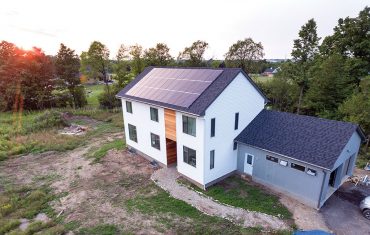
canadiancontractor
Five Principles of Passive House Design and Construction Part 5
Canadian Contractor"Buildings without humidification in winter can leave the interior spaces at low interior humidity, which leads to discomfort and damage to interior materials."

Passive House is considered the most rigorous voluntary energy-based standard in the design and construction industry today. Consuming up to 90 percent less heating and cooling energy than conventional buildings, Fundamental to the energy efficiency of these buildingsare the following five principles: 1) superinsulated envelopes, 2) airtight construction, 3) high-performance glazing, 4) thermal-bridge-free detailing, and 5) heat recovery ventilation. In this five-part series, Neil Norris, senior industry consultant for Passive House Canada outlines how the Passive House concept can inform conventional building.
Heat Recovery Ventilation
By Neil Norris
Since Passive House projects are airtight, a ventilation system is needed to bring in fresh air and exhaust out built-up pollutants, odours, CO2, and moisture. During winter, this means dumping out warm air and bringing in cooler air that needs to be heated up again, which increases the heating energy. A Passive House ventilation system uses a heat recovery ventilator (HRV) to continuously remove stale or moist air and deliver fresh air. During this process, it extracts heat from the exhaust air and puts it into the incoming air without directly mixing the air streams together. This way all the heat in the exhaust air is not completely lost to the outside. For a Passive House HRV, at least 75 percent of that heat needs to be recovered.
For warmer summer months, most Passive House-certified ventilation systems also feature a summer bypass damper that diverts air around the heat recovery core. That way the system can still bring in fresh air but does not recover heat when it is no needed.
In dry locations, like the prairies, buildings without humidification in winter can leave the interior spaces at low interior humidity (under 30 percent RH), which leads to discomfort, potential health issues, and damage to interior materials. In these cases, an Energy Recovery Ventilator (ERV) can be used. Unlike HRVs, which only transfer heat, ERVs can also transfer moisture from the outgoing exhaust to help maintain more-comfortable moisture levels in interior spaces. Occupants can also utilize natural ventilation (using cool summer breezes) from opening windows to replace exchange stale air by non-mechanical means and are encouraged to do so when it makes sense. Passive House designs utilize both methods to keep ventilation energy to a minimum. While Passive House projects can still be fitted with a heating system (such as air source heat pumps, electric baseboards, or boilers) having heat recovery in ventilation can greatly reduce the size, capacity, and maintenance needs of this equipment, shifting project costs from the mechanical systems to a superior building envelope.
Summary
The incredible year-round fresh indoor air quality and stable temperature, the substantial reduction in energy use and operating costs, and quiet atmosphere that Passive House standard delivers is directly attributed to these five principles and the way that they are integrated into a Passive House building. By following a holistic approach with these five principles through the design and construction on any project, owners, designers and builders can be confident that they can achieve a truly high-performance building.
Neil Norris is senior industry consultant, Passive House Canada
The 2019 Passive House Canada Conference takes place on October 17 & 18 at the University of Toronto Scarborough. The conference is a two-day deep dive into leading Passive House projects, best practices, and lessons learned. Program sessions will focus on Part 3 and 9 buildings, multi-unit residential buildings, retrofits, and hands-on skills seminars. Conference takes place on October 17 & 18 at the University of Toronto Scarborough. For more information or to register for the conference go to the Conference website.

Leave a Reply